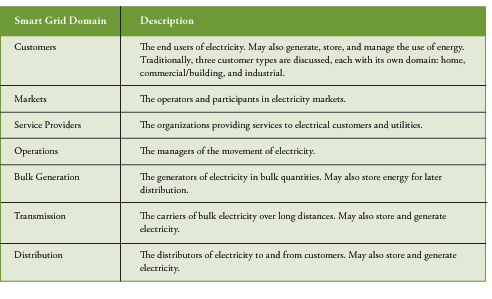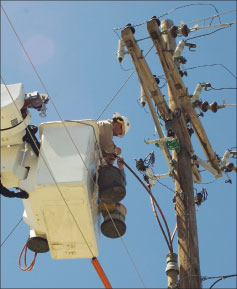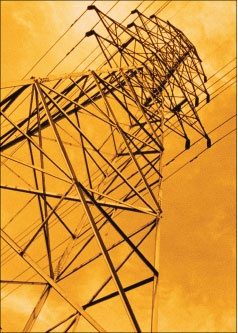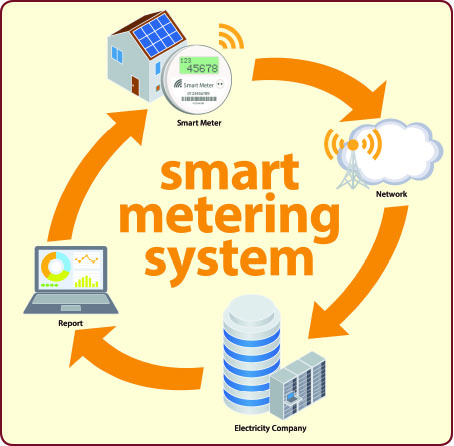Executive Summary
This report identifies and analyzes four immediate challenges for Smart Grid implementation: smart consumers, Smart Grid cybersecurity, Smart Grid interoperability, and smart transmission. Incorporating a wide range of observations by leading industry and government decisionmakers and academic experts, it highlights numerous technological and policy solutions that can play significant roles addressing these challenges. Specific policy recommendations for federal action to advance Smart Grid are proposed.
Introduction
The power grid…it’s that portion of the electricity transmission between the generating source and you, the consumer.
Your grid is in the process of getting a lot smarter. “Over 58 million smart meters will be deployed to mass market customers over the next 5 to 7 years,” predicted Lisa Wood, Executive Director of the Institute for Electric Efficiency. “That’s almost half of every U.S. household,” she said.[1]Those figures were calculated before the Obama Administration awarded $4.5 billion in stimulus dollars for an array of Smart Grid modernization projects.
But realizing the full benefits of Smart Grid goes beyond near-term steps like installing meters and improving delivery efficiency. It also depends on a series of long-term moves such as increasing the ability to transmit electricity across states and regions in order to tap renewable energy sources. Technologies are coming into the marketplace at different rates, too. Some elements of the Smart Grid, like smart meters, are moving fast. Other essential components, like grid-level energy storage, are advancing much more slowly. Moving forward requires change across many elements of the grid. “This is a once-in-a-lifetime opportunity to rewire America and rejuvenate one of our most critical infrastructures,” said George W. Arnold, coordinator for Smart Grid Interoperability at the National Institute of Standards and Technology (NIST).[2]
Why Success in Smart Grid Matters
By the early 2000s, concerns about grid congestion and reliability spurred the first major initiatives toward Smart Grid. Electricity delivery was seen first as an economic imperative. In 2008, the most recent year for which data is available, the value of electricity sales in the U.S. was a staggering $363.7 billion.[3]Electricity feeds economic growth. Rising demand for electricity often tracks closely with increasing gross domestic product, a fundamental component of a healthy economy.
In 2009, the Smart Grid grew into a full-fledged national commitment. President Barack Obama featured it prominently in his roll-out of the $787 billion stimulus package, including $4.4 billion earmarked for Smart Grid seed money.
“Today, the electricity we use is carried along a grid of lines and wires that dates back to Thomas Edison — a grid that can’t support the demands of clean energy,” said Obama. “This means we’re using 19thand 20thcentury technologies to battle 21st century problems like climate change and energy security. It also means that places like North Dakota can produce a lot of wind energy, but can’t deliver it to communities that want it, leading to a gap between how much clean energy we are using and how much we could be using. The investment we are making today will create a newer, smarter electric grid that will allow for the broader use of alternative energy,” Obama explained.
Given increasing demands on power generation, the Smart Grid offers the only gateway to increased use of renewable energy and decreased reliance on fossil fuels. Hydroelectric, wind and solar power offer tremendous potential, but unlike coal-fired plants, these energy sources are often located far from areas of bulk power demand. Tapping into renewables requires more advanced and flexible transmission.
That said, implementing Smart Grid is a multi-faceted challenge. Investment, regulation, business models, consumer education, cybersecurity and even weather in space are leading factors. The current American power grid evolved over more than half a century to take its present form. Yet with Smart Grid, the imperative is to push for greater adoption within a decade.
To date, technology breakthroughs and policy imperatives have both played their roles in pushing for Smart Grid. For all the White House attention, Smart Grid is not purely a matter of federal policy. Regulation sets standards and several federal entities from the Federal Energy Regulatory Commission (FERC) to NIST have been assigned responsibilities in Smart Grid implementation. It’s important to keep in mind that there is no single “Smart Grid czar” who can design and implement the grid of the future. The main engines behind Smart Grid at the national level have been federal American Recovery and Reinvestment Act grants and other Congressional legislation. Progress is a matter of aligning federal and state powers with market incentives, and crucially, with consumer enthusiasm and willingness to modify its energy consumption.
Vital momentum for Smart Grid implementation also comes from individual states. States such as California, Texas, Colorado, Massachusetts and West Virginia have all adopted distinctive approaches to encouraging Smart Grid implementation. Many are part of larger state-mandated energy goals. For example,Empower Maryland,a state mandated program, aims for a 14% efficiency improvement and peak power reduction by the year 2015. Beyond this, groups of states such as the Western Governors’ Association have formulated transmission siting initiatives critical to Smart Grid.
Conceptually, the Smart Grid consists of discrete but overlapping elements. To illustrate, one recent Smart Grid interoperability report from NIST divided the Smart Grid challenge into seven separate domains (seetable 1).[4]As this categorization implies, the ultimate implementation of a Smart Grid requires many steps in each domain area. The requirements for implementation range from consumer acceptance to commercial investment to separate state and federal government roles in devising long-range plans and creating the right regulatory environment.

Table 1. Domains in the Smart Grid Conceptual Model
Four Challenges for Smart Grid Implementation
Smart Consumers
Most plans for the Smart Grid center on significant changes in residential power. “The customer is ultimately the stakeholder that the entire grid was created to support,” noted a recent NIST report.[5]Pricing disparities by state also play a role. In 2008, the Energy Information Administration found the average residential price per kilowatt hour (kwh) was 11.26 cents. However, the high was Hawaii at 32.5 and the low was Idaho at 7 cents per residential kwh, with New York and California at 18 and 14 cents, respectively (seetable 2).
Implementing Smart Grid depends on resolving two critical factors that will redefine consumer interaction with their electric utility:
- The consumer’s embrace of the two-way monitoring technology which can help control peak power requirements.
- Implementing dynamic pricing that provides incentives for consumers to change their energy-use patterns.
One early vision for the Smart Grid pictured a full customer gateway. The gateway concept consists of smart meters creating a two-way transaction between the home and the utility. Under this concept, every home appliance would have a smart chip capable of performing brief shut-off and restart on command so a utility could temporarily reduce peak power demands.
Energy efficiency is the goal. It sounds simple enough, but in fact, at the consumer level there is a real challenge in gaining acceptance of the Smart Grid concept.
Take the installation of advanced meter infrastructure (AMI). One survey found that approximately 13.6 million homes in the U.S. had installed the AMI devices as of December 2009. Major utilities such as Baltimore Gas & Electric (BGE) are now actively marketing the meters with radio advertisements and public information across Maryland.
However, utilities also have work to do to improve their information resources. “Remember most utilities’ networks aren’t exactly robust given cost constraints and the fact that information technology hasn’t traditionally been their strong point (though hopefully that will change in the coming months and years),” observed one frequent commentator on Smart Grid progress.[6]

Table 2. Average residential price of electricity by states, 2008
Then there is the public relations angle. In some regions, electric utilities are coming off a decade where their public images suffered from seemingly arbitrary price rises. Californians recall rolling black-outs that darkened traffic lights, stranded people in elevators and forced hospitals onto emergency generators. Not all consumers are interested in “Smart Grids” to begin with and many have voiced objections when electricity utility bills have increased to offset the costs of the investment. State Public Utility Commissions have registered concern when utilities, many of which are publicly-traded companies responsible to stockholders, have filed rate increase requests, and in some cases have taken steps to increase the scope of their regulatory scrutiny.
Consider these findings from a national survey conducted by Parks Associates as part of its Residential Energy Management service to determine consumer mindset regarding energy management solutions:
- Over 80% of consumers are very interested in learning how to cut their energy costs, but less than one-half want to learn more about Smart Grid.
- 80–85% of households are willing to pay $80-$100 for cost-saving equipment if they are guaranteed to save 10–30% off their monthly electricity bills.
- Only 15–20% of consumers are likely to sign up for time-of-use or demand-response programs; 35% do not want utilities to control systems in their home regardless of the savings potential.[7]A crucial goal for Smart Grid implementation will be honest public information campaigns that explain the benefits and put it in terms consumers appreciate and can use. “What does it cost to run a load of dishes? Bake a turkey? Watch I’m a Celebrity, Get Me Out of Here? Unless you’re a power geek, you don’t know,” wrote one Baltimore Sun reporter covering BGE’s foray into smart meters.[8]The 2009 stimulus from the U.S. Department of Energy includes projects that could help build consumer acceptance. For example, San Diego Gas and Electric will install wireless systems supporting 1.4 million smart meters and provide dynamic pricing.
Although widespread metering and conservation is the ideal, it will take several steps to reach that end-state. After meter installation come steps like dynamic pricing. Dynamic pricing includes offering customers cheaper rates per kilowatt hour at off peak times, for example. With price incentives, consumers may choose to run their energy-intensive applications at different times of the day.
The fact is that consumer reaction will be critical to the implementation of Smart Grid. Accordingly, consumer attitudes have now attracted federal attention. NIST launched an initiative in February 2010 to ensure that the consumer interface to the Smart Grid enables households to optimize their energy use “and encourage widespread consumer adoption.”[9]

Photo 1. With Smart Grid, load control switches like the one pictured here can be set to lock out loads during expensive, peak-power periods.
Two long-term issues can perturb consumer acceptance of Smart Grid. First is providing adequate assurances that electric utility consumers are not asked to shoulder an excessive burden to pay for the modernization. One set of questions that will need to be resolved is to what extent consumers in a particular state should be asked to subsidize transmission technology that provides some benefits but also crosses state boundaries. Second, while efficiencies promise savings over time, transparency will show up in pricing disparities. Power plants are amortized over 30 years. But consumers understandably look at just two or three years to see how smart meters, energy efficient appliances, and larger regulatory price changes affect their balance sheets at home.
While most agree that consumers need to be let in on the benefits of variable pricing, some point out that it comes with risks. Changes in pricing are likely to cause at least short-term turbulence and fuel some opposition to Smart Grid implementation. “Half the country’s above average and half is below,” for pricing, as one expert noted. “And the grid flattens that out. It will have many local enemies, okay?”[10]As a result, full implementation will also require a more subtle approach to marketing opt-in programs. “As utilities gain a better understanding of their consumer segments and move into their homes with smart technologies, the utility business model must shift to more of a service provider role, offering different plans for different lifestyles, much the way cell phone companies and cable and satellite providers operate,” suggested one expert.[11]

Photo 2. Interior Department fast-tracking on rights-of-way land it manages in Idaho, California and Nevada is expected to add more than 1,000 miles of new transmission lines.
Second is the issue of privacy. “The ability to access, analyze, and respond to a much wider range of data from all levels of the electric grid is a major benefit of the Smart Grid, but it is also a significant concern from a privacy viewpoint,” acknowledged NIST.[13]“The Smart Grid offers great promise for fighting climate change and improving energy policy, but it can also amass vast amounts of data that reveals intimate details of consumers’ lives,” pointed out Jennifer Lynch, an attorney with the Samuelson Clinic.
The Smart Grid promises great benefits to consumers and the environment, including lowered energy costs, increased usage of environmentally friendly power sources, and enhanced security against attack and outage. At the same time, however, the Smart Grid presents new privacy threats through its enhanced collection and transmission of detailed consumption data — data that can reveal details about activities within the home and that can easily be transmitted from one party to another.
Smart Grid implementation will generate more data, over longer periods of time, and spread it more widely. Gone are the days of once-a-month meter readings fed into the computer doing the billing. Smart Grid devices will churn out data on activities in the home, and that data in aggregate form will be coveted by those developing applications for Smart Grid, for example. Aggregated data may play a vital role in application development and monitoring of trends, much as it has done for decades. But the highly refined and personal data emanating from Smart Grid practices must be safeguarded.
“Building privacy protections into the Grid from the beginning protects both the environment and consumers from harm.”[12]
Cybersecurity on the Grid
Safeguards are also vital in yet another challenge area for Smart Grid implementation: cybersecurity.

Photo 3. Within 60 days of smart meter installation, consumers can view their energy usage down to 15-minute intervals, without waiting for their monthly bill.
As with other forms of innovation, Smart Grid comes with benefits and drawbacks. Use of the internet to link data flow between utilities and customers creates a need to address cybersecurity. “Remote access to control systems poses a huge danger,” said Dr. Phyllis Schneck, McAfee’s vice president of threat intelligence. “We must either protect it appropriately or move it to more private networks and not use the open Internet,” added Schneck, a member of the Center for Strategic and International Studies’ Commission on Cybersecurity for the 44thPresidency.[14]A byproduct of the transition to Smart Grid will be generation of more consumer data — with more potential vulnerabilities. Smart Grid depends on sophisticated control of supply and demand based on a vast amount of data generated by the daily energy usage of millions of consumers. It is data that determines the approach to peak power loads and when to briefly shut off power devices in Smart Grid-equipped homes. And what will carry that data? The internet, of course.
Concerns about Smart Grid stem from the fact that easy-to-use meters also open vulnerabilities. “Smart meters give consumers direct access to information about their power usage and the ability to manage that usage over the Web, but that two-way communication also opens up the possibility that the grid could be attacked from the outside,” noted a recent report. Many of the Smart Grid systems “require little authentication to carry out key functions, such as disconnecting customers from the power grid,” the report continued.[15]Even far less insidious acts could do considerable long-term damage, such as customers hacking into data to roll back the meter on their utility bills.
For decades, power system operations have been managing the reliability of the power grid in which poweravailabilityhas been a major requirement, with information integrity as a secondary but increasingly critical requirement,” noted NIST.[16]Compromise of customer data, however, is not the only concern. Smart Grid technologies look to govern much of the grid’s operation, too. “Vulnerabilities might allow an attacker to penetrate a network, gain access to control software, and alter load conditions to destabilize the grid in unpredictable ways,” hypothesized the experts at NIST.[17] Is the power grid really a tempting target? Apparently so, say intelligence officials. In fact, several elements of the nation’s cyberspace structure come under daily attack. “The Chinese have attempted to map our infrastructure, such as the electrical grid,” said a senior intelligence official. “So have the Russians.”[18]The report suggested hackers may have tried to leave behind access paths. “If we go to war with them, they will try to turn them on,” the intelligence official told The Wall Street Journal.[19] China later denied ambitions to tap into U.S. infrastructure, but for many, The Wall Street Journal’s 2009 report crystallized nascent fears about the vulnerability of the Smart Grid.
Highly secret military systems are secured by encryption and physical access. The Smart Grid, in contrast, aims to exploit wireless technology and will have numerous participant points of access — all ripe targets for hackers. Securing the information fl ow could be a key determinant of success for Smart Grid, and the problem has been put in very capable hands. “We could open the door to new risks if we carelessly put together new systems that don’t have resilience and security guarantees built in from the ground up,” said Ilesanmi Adesida, dean of the college of engineering at the University of Illinois.[20]The university’s Information Trust Institute is home to a $26 million Trustworthy Cyber Infrastructure for the Power Grid Center, a leading research operation for evaluating the effectiveness of defenses against attacks on the nation’s energy grid and developing new security tools.
NIST took on responsibility for cybersecurity for Smart Grid in 2007. The Energy Independence and Security Act of 2007 empowered NIST with “primary responsibility to coordinate development of a framework that includes protocols and model standards for information management to achieve interoperability of Smart Grid devices and systems…” The 2009 American Recovery and Reinvestment Act added money to the NIST budget for development of a comprehensive cybersecurity plan for the grid.
Since that time, NIST has established a Smart Grid cybersecurity operating group and drafted plans for grid security standards. The core of the approach embraces best practices in cybersecurity, such as designing in security from the start.
However, NIST is still in the process of identifying cybersecurity standards. At present, only the North American Electric Reliability Corporation Critical Infrastructure Protection standards are mandatory for the bulk electric system.[21]
Other standards are available but not fully implemented. For example, there is a document that sets out standards for cybersecurity for intelligent electronic devices at substations, but it is not yet part of the mandatory NIST-governed interoperability standards.[22]
Setting standards is only part of the equation. According to an estimate by Pike Research, utility companies around the world could spend $21 billion by 2015 to improve cybersecurity.[23]That figure would be about 10% of the estimated $200 billion global investment in Smart Grid.

Photo 4. Today some 157,000 miles of high-voltage transmission lines carry electric power across the continental United States.
In the United States, the keys to implementing greater cybersecurity begin with NIST’s assessment of vulnerabilities and its 2010 strategy for securing the devices that enable the grid. Cybersecurity for Smart Grid is somewhat different than cybersecurity for other sectors because of the need to protect a wide array of devices connected to and enabling the grid. Encryption, limited physical access, and “white hat” techniques (barring access to all but safe users) are common to military cybersecurity, for example. Training of employees to resist social engineering threats — such as inadvertently disclosing passwords or identity clues — has been proven to be critical even in the most heavily secured organizations. Part of the Smart Grid cybersecurity challenge will be to implement standards at all levels and in all domains, from the consumer to the Supervisory Control and Data Acquisition (SCADA).
So far, NIST has approached the process by examining the grid as a whole and assessing risk across its different domains. Key areas identified include electric transportation, electric storage, wide area situational awareness, demand response, advanced metering infrastructure, and distribution grid management. The list underscores the diversity of the solution set for Smart Grid cybersecurity. A significant number of federal documents already outline cybersecurity standards. By the end of 2010, an NIST architecture will be in place to set standards across all domains of Smart Grid.
Then the challenges begin. Organizations may adopt recommended cybersecurity standards directly, or put in place what NIST calls “compensating” measures, which may be composed of one or more solution sets. Either way, cybersecurity planning will become a foundation element of Smart Grid technologies under federal mandate. Ultimately, as the Chairman of the New York State Public Service Commission told a Congressional subcommittee in October 2009, “In spite of introducing new vulnerabilities, Smart Grid fundamentally makes the electric system more secure.”[24]Security comes just as much in the form of increased reliability as it does from cyber protection.
Interoperability: The Shift to Common Standards
Smart Grid implementation ultimately depends on linking numerous devices at several points of the model into a seamless flow of data. That can’t be done with proprietary software or meters that don’t talk to the database at the utility. Open-architecture solutions and agreed standards for Smart Grid devices represent a key step forward in implementation.
The quest for Smart Grid standards to facilitate interoperability is “the most complicated issue facing the Smart Grid industry — and it’s developing amidst on-the-ground deployments of technologies both proprietary and open, all of it needing to interoperate with decades-old utility systems.”[25]

Photo 5. A 1989 Canadian blackout affecting 9 million people was caused by currents produced by a large geomagnetic storm.
One of the best everyday examples of interoperability standards is the USB port. Behind devices such as memory sticks and cameras lies a detailed set of standards that support physical compatibility and exchange of data and metadata. Many different companies in the U. S. and abroad create devices and write code guided by these standards. Done right, interoperability standards ensure functionality and security and lay the groundwork for a viable commercial market.
In the future, standards must include a number of interfaces such as the communication between the grid and plug-in vehicles. The quest for standards is not an easy one. Fortunately, NIST is well-placed to comb through the requirements and set action plans. Speeding up development of interoperability standards will also smooth the path for commercial manufacturers — a needed step to normalizing Smart Grid technologies.
Interoperability standards range far and wide and include taking into account external factors such as weather in space. “Space weather can produce solar storm electromagnetic fields that induce extreme currents in wires, disrupting power lines, causing wide-spread blackouts and affecting communication cables that support the Internet,” concluded a 2009 study by the National Academy of Sciences.[26] The worst storms may be once-in-a century events, but big flares have occurred in 1976, 1989 and 2003.

Photo 6. Supplemental transformer neutral ground resistors reduce geomagnetically induced current flows, according to a study by the National Academy of Science. (Photo: Simplx.)
Big solar flares create geomagnetic storms that can disturb electricity on the Earth’s surface. A massive solar flare blacked out 6 million power customers in Canada in 1989, for example. An even larger flare in 2003 created a plasma cloud that travelled toward earth at 5 million miles per hour. The flare created a G5 level storm — the highest on the astrophysicists’ scale for these events. “It’s arriving earlier than anticipated. It’s a little bit surprising it got here so fast,” said John Kohl, a solar astrophysicist at the Harvard-Smithsonian Center. Satellite sensors shut down or risk frizzling in the energy of the plasma.[27]
For Smart Grid, the geomagnetic currents pose two problems. First is the potential for power lines to surge, while the second is disruption of terrestrial and satellite communications embedded in Smart Grid. With more reliance on communications to ensure delivery and demand tracking, making Smart Grid elements impervious to solar weather will be among the many imperatives for implementing the grid.
One technology solution may come from the installation of supplemental transformer neutral ground resistors to reduce geomagnetically induced current (GIC) flows. The technology is relatively inexpensive, has low engineering trade-off s, and can produce 60–70% reductions of GIC levels for storms of all sizes.
Beyond this, the March 2010 launch of the latest National Polar-orbiting Operational Environmental Satellite System weather satellite included enhanced space weather capabilities.
The Long Haul: Smart Transmission
With all the focus on meters and standards, it’s easy to forget that restructuring the grid for better transmission of resources is the other major component of implementing the Smart Grid.

Photo 7. The world’s first HTS power transmission cable system. HTS cables can reduce the growing costs of electricity lost in transmission and distribution.
Transmission lines expanded from local plants to local communities in the 20thcentury. Today about 157,000 miles of high-voltage transmission lines carry bulk power in the continental United States. The grid is organized into three major sectors: the Eastern, Western and Texas interconnections, with links to Canada and Mexico (see table 3). It’s a grid that covers U.S. territory, but its flexibility is limited.
Putting electricity generated by renewables onto the grid depends on building more and different high-voltage transmission lines. Just how does wind power from Delaware arrive in upstate New York? “Transmission is ultimately the key,” said Jon Wellinghoff, Chairman of the FERC. “If we cannot put the transmission in place, we cannot deliver it to loads, and so we have to somehow look at the fundamentals of what’s necessary to make that transmission into a system that ultimately can provide deliverability and marketability of these renewable resources.”[28]Near-term, improved efficiency is the goal. If the grid were just 5% more efficient, the energy savings would equate to permanently eliminating the fuel and greenhouse gas emissions from 53 million cars,” found the Department of Energy in a 2008 report.[29]Several new technological developments could aid transmission efficiency. The discovery of high temperature superconductivity (HTS) materials in 1986 soon netted a Nobel prize for IBM Researchers Karl Müller and Johannes Bednorz.








Find Us on Socials